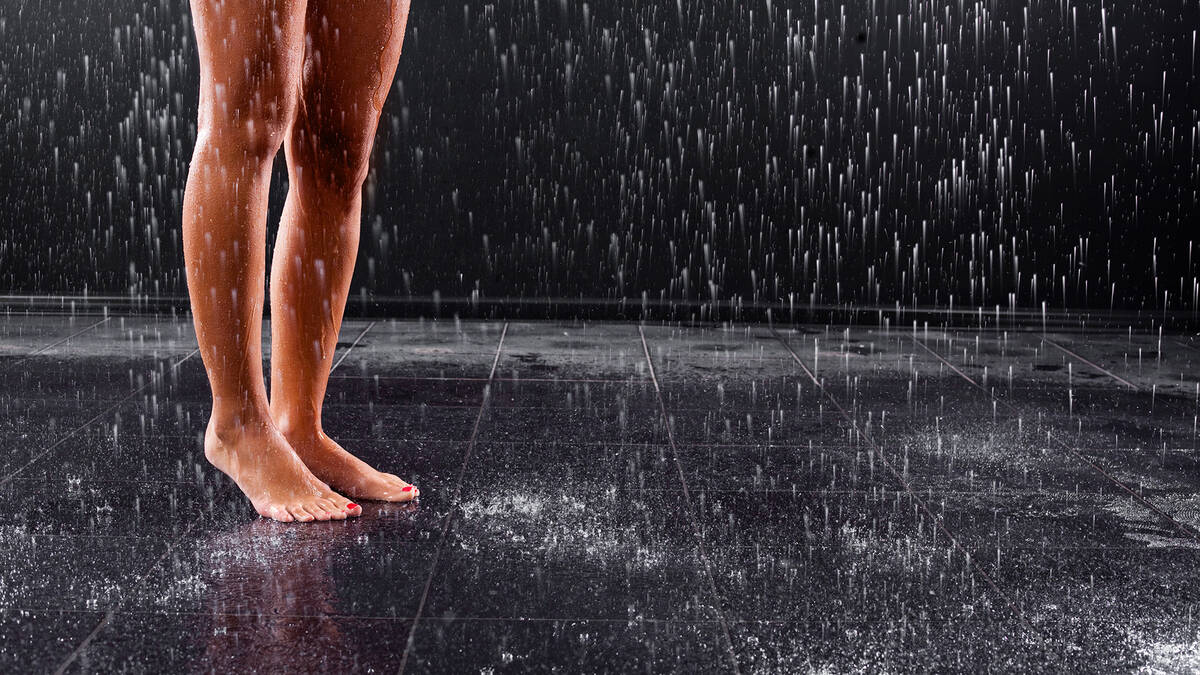Shower safely with the right flooring
Slip-resistant tiles for more safety in the bathroom
Warning: slip hazard! Water transforms flooring surfaces into serious sources of danger. Slip-resistant tiles mitigate this risk without hampering the design or functionality. In this article, we showcase suitable options for the bathroom in appealing designs and explain what slip ratings mean so that you and your loved ones can always have a firm footing on your flooring.

These tiles ensure a firm footing
People of all ages can easily slip and fall on wet floors. From slight to severe, injuries in the bathroom are daily occurrences. For example, every year around 250,000 people injure themselves in this room in Germany alone. The consequence? Bruises and broken bones, mainly on the arms and hands.
Slip-resistant models significantly increase safety in the bathroom through their rough surface finish. They are available in numerous materials to suit all interior design styles.
You have the choice of the following options with slip-resistant properties:

- Elegant stone effect: Porcelain stoneware features an impressive natural look that imitates natural stone deceptively well. These ceramic tiles are fired at extremely high temperatures and are ultra-durable. Unglazed tiles have a rough surface to prevent slipping. Glazed tiles in a natural stone effect feature an extra layer of unevenly textured glass, which also increases the slip resistance.
- Stylish concrete effect: They give the room the coveted industrial look and are therefore perfect for fans of minimalist design. Just like stone-effect tiles, they are made of robust porcelain stoneware. Their uneven texture automatically provides steady footing.
- Unusual wood effect: Alongside natural stone and concrete, porcelain stoneware can imitate wood uncannily well. The wood grain produced here makes the upper surface uneven, thus ensuring a firm footing. This flooring is great if you want to complement elements made of genuine wood in your bathroom.
- Eye-catching, decorated tiles: Tiles with ornamental designs create beautiful accents to break up the room. If patterned flooring is too much for you, what about a border or a decorative island surrounded by monochrome tiles?
- Textured patterns: This ceramic flooring not only features an impressive, colourful design, but it also has relief-like patterns on the surface. The unevenness and rough glazing creates a slip-resistant effect.
- Small mosaic tiles for creative freedom: The small size of the tiles automatically gives this flooring slip-resistant properties. Their edge length is between two and ten centimetres. The shorter the length, the more grout there is to provide support. Most tiles also have a textured surface. Mosaic tiles come in numerous colours to produce all kinds of designs – from ornamental right through to ombre.
What do the various anti-slip tile ratings mean?
Tiles are given anti-slip tile ratings ranging from R9 to R13. The rating reveals which inclination angle is safe when a tile is covered with oil. The ratings indicate how large the inclination angle can be for safe walking and standing on the tiles. These ratings apply to rooms used for commercial purposes, although they can also act as a guide for bathroom design in residential properties.
- R9: These models are only slightly slip-resistant. The safe inclination angle is between 6 and 10 degrees. They are suitable for dry rooms such as living rooms and bedrooms.
- R10: This medium slip-resistance is considered safe for all surfaces that need to withstand high levels of moisture, for example in the kitchen, bathroom or garage. The maximum inclination angle for safe movement is 10 to 19 degrees.
- R11: This safety rating is recommended for outdoor areas such as terraces and stairs. The safe inclination angle is between 19 and 27 degrees here.
- R12/R13: For spaces with a very high risk of slipping, we advise opting for these two anti-slip tile ratings. These areas include swimming pools and saunas. For R12, the inclination angle is between 27 and 35 degrees, while R13 is for tiles positioned at an angle of more than 35 degrees.
R10 is usually sufficient for a household bathroom, but you can also play it safe by opting for the R11 rating in floor-level showers.
In addition to these ratings, there are also A, B and C classifications, which describe the slip resistance in barefoot areas. A, B and C indicate the slip resistance of the tile when covered with water. ‘A’ stands for models that occasionally get wet, such as tiles in in changing rooms. The B classification is given to models that frequently get wet, such as tiles at the edge of swimming pools or in shower room flooring. Tiles that are permanently wet, such as the ones used in swimming pools, receive the letter C.
Slip-resistant tiles for sure footing
A moist or wet bathroom floor can be hazardous for anyone. Slip-resistant flooring prevents accidents and ensures attractive design. Tiles with slip resistance are available in a wide range of designs to complement all styles. The R9 to R13 ratings indicate to what extent people could move safely on an angled slippery surface.
Frequently asked questions about tiles with a slip-resistant surface
Porcelain stoneware with a slip-resistant finish is available in a variety of designs. You can imitate natural stone, concrete and wood grain deceptively well with its effects.
Unlike colourful decorations, these patterns feature a relief-like surface. This texture offers a firm footing.
The small size of the tiles requires lots of grout, which creates grip underfoot. The surface is also often textured for extra hold.
Normally, the R10 rating is sufficient. We recommend R11 in areas that frequently get wet, such as a floor-level shower.
They indicate the slip resistance in barefoot areas. A means low slip-resistance and C means high slip-resistance.
Authorised dealers